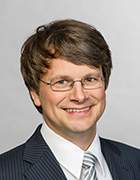
Prof. Dr. Bastian Märkisch
Academic Career and Research Areas
The research area of Bastian Märkisch (b. 1974) focuses on precision experiments in particle physics at low energies in search of physics beyond the standard model. His particular focus lies in measurements on the weak interaction in the decay of free neutrons. Experiments are performed at leading neutron sources such as FRM II, Garching, and the Institut Laue-Langevin, Grenoble.
Märkisch studied physics at the University of Heidelberg and the University of Edinburgh and completed his PhD in 2006 in Heidelberg. This was followed by several research visits to Institut Laue-Langevin, Grenoble, where he subsequently took up a position as a scientist. Since 2010 he has headed a research group at the Physikalisches Institut of Heidelberg University within the framework of a priority program of the German Research Foundation (DFG) : SPP 1491 - Precision experiments in particle-and astrophysics with cold and ultracold neutrons. In 2015 he was given a faculty appointment at TUM.
Key Publications (all publications)
Dubbers D, Märkisch B: “Precise Measurements of the Decay of Free Neutrons”. Ann. Rev. Nucl. Part. Sci. 2021; 71: 139-163.
AbstractSaul H, Roick C, Abele H, Mest H, Klopf M, Petoukhov A, Soldner T, Wang X, Werder D, Märkisch B: “Limit on the Fierz Interference Term b from a Measurement of the Beta Asymmetry in Neutron Decay”. Phys. Rev. Lett. 2020; 125: 112501.
AbstractMärkisch B, Mest H, Saul H, Wang X, Abele H, Dubbers D, Klopf M, Petoukhov A, Roick C, Soldner T, Werder D: “Measurement of the weak axial-vector coupling constant in the decay of free neutrons using a pulsed cold neutron beam”. Phys. Rev. Lett. 2019; 122: 242501.
AbstractWerner L, Trunk M, Gernhäuser R, Gilles R, Märkisch B, Révay Zs: “The new Neutron Depth Profiling Instrument N4DP at the Heinz Maier-Leibnitz Zentrum“. Nucl. Instr. Meth. A. 2018; 911, 30-36.
AbstractDubbers D, Abele H, Baeßler S, Märkisch B, Schumann M, Soldner T, Zimmer O: „A clean, bright, and versatile source of neutron decay products”. Nucl. Instr. Meth. A. 2008; 596(2): 238-247.
AbstractIf you wish your profile to be changed or updated please contact Franz Langer.